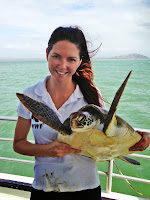When people ask what I
do for work and I reply that I am a marine biologist, most people seem to have
the impression of this exciting life where marine biologists are continually
out in the field in exotic locations. Although we do get out in the field in
some amazing places (mind you, some are not so amazing), the majority of our
time can be spent in front of a computer analysing data, writing reports and publications
or in a laboratory analysing samples.
Saturday 28 December 2013
Monday 23 December 2013
Recreational divers - sharing the OceansIQ dream!
A few weeks ago, Alison and Adam gave a talk in South Africa at the Save Our Seas Shark Centre, which we wrote about here. We are very happy that Clare Lindeque, from Learn to Dive Today Dive Centre in Cape Town attended this talk. Clare has written a couple of great blog posts about the talk we gave and our research on sevengills. These posts feature great descriptions sevengills, our work and the importance of engaging local divers to assist in learning more about these amazing sharks.
We thank Clare for actively spreading information about seven gill sharks and our tagging program, and for promoting the Spot the Sevengill Shark Facebook page.
We here at OIQ all started our affinity with the ocean as recreational divers or snorkellers Let's face it, recreational diving is the reason we know anything about marine life at all!!
As ongoing ocean observers, divers have always been in fantastic positions to bring attention to, care for and spread the word about marine life. With today's ease of underwater photography, divers can now add to this stewardship by joining scientists in identifying individuals though photo capture. Yay for citizen scientists!
Here are links:
Lecture: Adam Barnett & Alison Kock update on sevengill cowshark research in False Bay
Lecture: Adam Barnett on broadnose sevengill cowsharks
Thanks again for the posts, Clare, and keep on boosting people's Ocean IQ's!
We thank Clare for actively spreading information about seven gill sharks and our tagging program, and for promoting the Spot the Sevengill Shark Facebook page.
We here at OIQ all started our affinity with the ocean as recreational divers or snorkellers Let's face it, recreational diving is the reason we know anything about marine life at all!!
As ongoing ocean observers, divers have always been in fantastic positions to bring attention to, care for and spread the word about marine life. With today's ease of underwater photography, divers can now add to this stewardship by joining scientists in identifying individuals though photo capture. Yay for citizen scientists!
Here are links:
Lecture: Adam Barnett & Alison Kock update on sevengill cowshark research in False Bay
Lecture: Adam Barnett on broadnose sevengill cowsharks
Thanks again for the posts, Clare, and keep on boosting people's Ocean IQ's!
Labels:
citizen science,
Sevengill Sharks,
South Africa
Active Acoustic Tracking - A guide to tagging and tracking (Part 2)
In our first post in this series, we covered passive
acoustic tracking, a method of tracking marine animals. In this post, we look
at a second method using sound – active acoustic tracking.
Active Acoustic Tracking
Active tracking can be likened to follow the leader, or a game of hide and seek. It differs from
passive tracking because it relies on real-time listening and following the sound, rather than using a stationery receiver to record the information. It allows us to build a fine scale map of the animal's movements and behaviours.
Thursday 19 December 2013
Flatback turtle whereabouts
By Christine Hof,
Species Conservation Project Coordinator WWF Australia
I
remember many years ago swimming with turtles on the Great Barrier Reef. Through
this experience I was transported into their world, the underwater world and I
was hooked!
Fast
forward 10 years and I’m now part of that world. And while I know a lot more
about marine life – there is still much to explore and to learn.
So
that’s why last week I was one and half hours south of Townsville, surrounded
by the waters of Upstart Bay. Along a 15km stretch of beach - Wunjunga beach - flatback
turtles, Australia’s only endemic marine turtle, come to nest.
Saturday 14 December 2013
How to follow an animal you can’t follow - A guide to tagging and tracking
Observing animals underwater has obvious limitations. In most cases, we can't really see what's going on from the surface, and even with SCUBA diving, we can only stay underwater for a limited time. This is a problem for marine researchers trying to follow our ocean animals, especially when the most basic of questions to ask is -
"Where do they go?"
Even just for basic information on animals, we need to know where they go, when they go there, and what they’re doing. Unlike mapping where stationery species like plants and corals are found, determining distributions for moving animals is more difficult, particularly in the aquatic environment where our ability to observe mobile animals is severely limited.
Subscribe to:
Posts (Atom)


